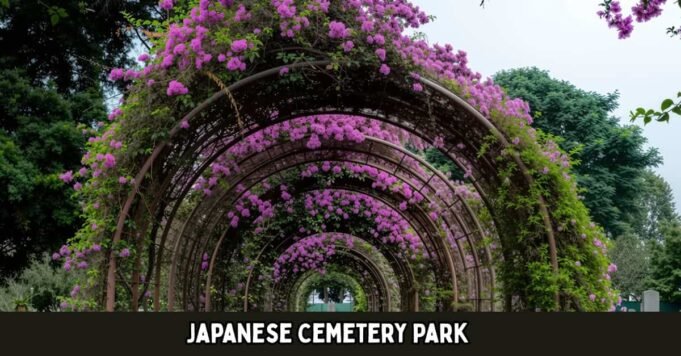The Japanese Cemetery Park, a hidden gem located in various parts of the world, serves as a testament to the deep cultural connections between Japan and the places they have influenced over the centuries. This serene and historical site offers a fascinating glimpse into Japanese heritage, allowing visitors to reflect on the past while immersed in nature’s beauty. Suppose you’ve ever wondered about the significance of Japanese Cemetery Parks or are planning a visit.
In that case, this article will explore their importance, history, and why they deserve a place in your travel itinerary.
What is a Japanese Cemetery Park?
A Japanese Cemetery Park is a memorial site dedicated to the Japanese community and individuals who have made significant contributions to the development of their respective countries. These cemeteries often serve as a resting place for Japanese immigrants, expatriates, and their families who passed away far from home. Typically located in areas with historical ties to Japan, these parks are peaceful retreats filled with rich cultural symbolism, art, and traditions.
One of the most notable characteristics of Japanese Cemetery Parks is their serene and meticulous landscaping. The cemeteries often feature beautiful gardens and traditional Japanese elements like bonsai trees, stone lanterns, and water features that embody the Japanese appreciation for nature and simplicity.
Read: Shrubbery Nightingale Park, Darjeeling
Historical Significance of Japanese Cemetery Parks
Japanese Cemetery Parks have historical importance as they reflect the story of Japanese immigration, trade, and relationships with various countries. Many of these cemeteries can be found in places like Singapore, Malaysia, and the Philippines, where Japanese communities have historically thrived.
These parks often contain gravestones, monuments, and plaques with inscriptions that provide valuable insight into the lives of the Japanese settlers and their contributions to the local culture, economy, and society. The cemeteries stand as a symbol of the enduring bond between Japan and these countries, helping to bridge cultural gaps and fostering mutual respect.
The Japanese Cemetery in Singapore
One of the most famous Japanese Cemetery Parks is the Japanese Cemetery in Singapore. Established in the early 20th century, this cemetery is one of the largest of its kind in Southeast Asia. It was created to provide a final resting place for Japanese nationals who lived and worked in Singapore.
Today, the Japanese Cemetery in Singapore remains an important cultural landmark. The park offers a peaceful atmosphere where visitors can explore the beautifully maintained grounds, reflect on the lives of the Japanese settlers, and learn about their contribution to Singapore’s development. The cemetery is also home to a significant number of tombstones that reflect both traditional and modern Japanese craftsmanship.
Read: 15 Best Hikes in Shenandoah National Park
Cultural and Aesthetic Features
Japanese Cemetery Parks are not only places of remembrance but also serve as visual representations of Japanese aesthetics and cultural practices. The layout of these parks often follows the principles of Japanese garden design, focusing on harmony, balance, and tranquility.
Traditional Elements
Some of the common elements found in Japanese Cemetery Parks include:
- Bonsai Trees: These miniature trees symbolize patience and the deep connection between humans and nature.
- Stone Lanterns (Tōrō): Stone lanterns are placed throughout the park to provide subtle lighting and create an atmosphere of peace and reverence.
- Water Features: Ponds, small streams, and fountains are common in Japanese cemetery parks, symbolizing the flow of life and offering a calming effect to visitors.
- Statues and Shrines: Buddhist statues and shrines can often be found within these spaces, offering a sense of spirituality and reflection.
Landscape Design
The landscaping of these parks adheres to the principles of “wabi-sabi,” the Japanese aesthetic that embraces imperfection and transience. Gravel paths, moss-covered stones, and intricate bonsai gardens highlight the understated elegance of Japanese cemetery parks. This design philosophy encourages visitors to appreciate the quiet beauty of the park and meditate on the fleeting nature of life.
Visiting a Japanese Cemetery Park: Tips for a Respectful Experience
When visiting a Japanese Cemetery Park, it’s important to approach the experience with respect for the cultural and spiritual significance of the space. Here are some tips to ensure you have a meaningful and respectful visit:
- Dress Modestly: Japanese Cemetery Parks are sacred spaces, so visitors are advised to dress modestly and appropriately, avoiding loud or disruptive behavior.
- Respect the Quiet Atmosphere: These parks are places for reflection and remembrance, so maintaining a quiet and serene environment is essential. Take time to appreciate the surroundings without disturbing others.
- Learn About the History: Before visiting, take some time to read about the history of the cemetery and the individuals buried there. This will deepen your appreciation for the significance of the site.
- Honor Local Customs: If the park features shrines or other religious symbols, it’s important to respect local customs when interacting with these elements. For example, bowing slightly or offering a quiet prayer is a respectful gesture.
Read: Cathedral Caverns State Park
Why You Should Visit a Japanese Cemetery Park
Visiting a Japanese Cemetery Park offers more than just a historical experience—it provides an opportunity to immerse yourself in a space that embodies peace, reflection, and the beauty of cultural heritage. The serene gardens and thoughtful design encourage visitors to slow down, contemplate, and connect with nature.
Additionally, these parks offer insight into the deep cultural ties between Japan and various countries. They serve as reminders of the shared history and mutual respect that transcend borders. Whether you’re a history buff, a lover of nature, or someone looking for a peaceful place to reflect, a visit to a Japanese Cemetery Park is sure to leave you with a sense of calm and appreciation for cultural diversity.
Frequently Asked Questions
1. What is the Japanese Cemetery Park in Singapore?
The Japanese Cemetery Park is a historic site located in Chua Chu Kang, Singapore, serving as a burial ground for members of the Japanese community who lived in Singapore.
2. Why is the Japanese Cemetery Park significant?
It is significant because it holds the graves of early Japanese immigrants and their descendants who contributed to the development of Singapore, especially during the late 19th and early 20th centuries.
3. How many graves are there in the Japanese Cemetery Park?
There are over 900 graves in the park, including those of prominent figures from the Japanese community.
4. Can I visit the Japanese Cemetery Park?
Yes, the park is open to visitors daily from 7:00 AM to 7:00 PM. It is free to enter.
5. What are the key cultural symbols found in the park?
The park features traditional Japanese elements such as stone lanterns, koi ponds, and torii gates.
6. What rituals are associated with the Japanese Cemetery Park?
Rituals such as Shinto and Buddhist funeral ceremonies, which involve prayers and offerings to the deceased, are often held in the park.
Read: Meaher State Park
Conclusion
Japanese Cemetery Parks are much more than just burial grounds—they are beautiful, tranquil spaces that celebrate the lives and contributions of Japanese settlers around the world. With their serene landscapes, rich history, and cultural significance, these parks offer an unforgettable experience for anyone seeking to learn more about the historical ties between Japan and other nations. Whether you’re looking for a quiet place for contemplation or simply wish to appreciate the beauty of Japanese garden design, the Japanese Cemetery Park is a must-visit destination.
So, next time you’re in a city with a Japanese Cemetery Park, make sure to take some time to explore it and immerse yourself in the peaceful serenity it has to offer.
















[…] Related: Beauty of Japanese Cemetery Park […]
Comments are closed.